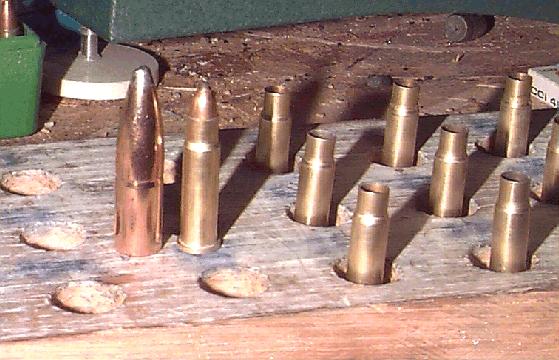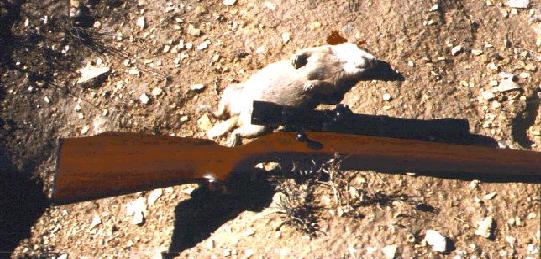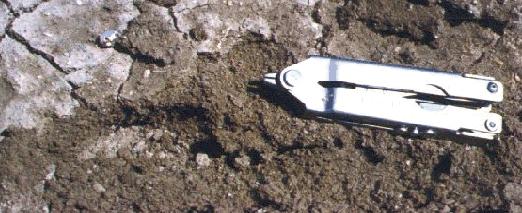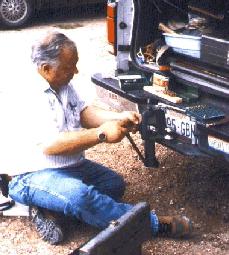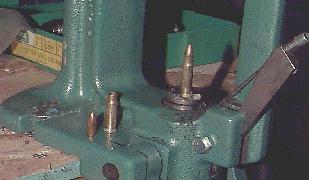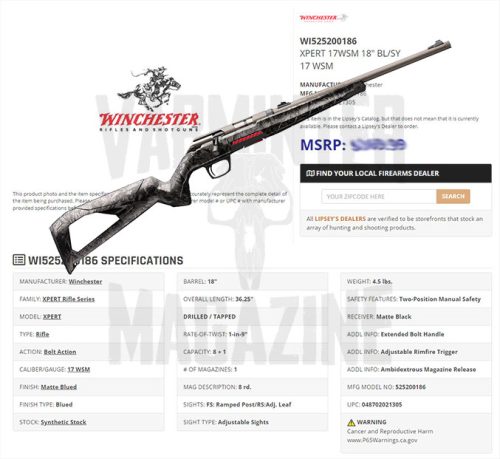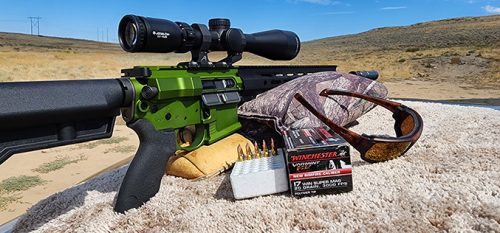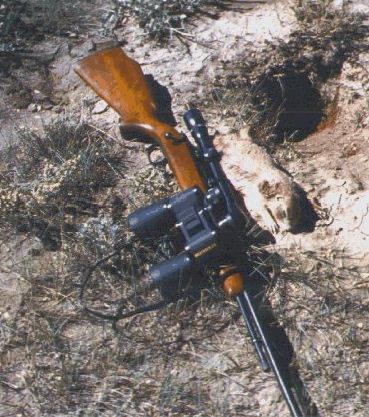 Fresh cool air, still moist from the thunderstorm yesterday flowed through the cab of my Explorer as I sat along side the county road in South Eastern Wyoming. Glassing the prairie through the 10x Bushnell binoculars showed a scene that I had been waiting for a number of years. Prairie dog mounds that just kept going as far as the horizon. As I swiveled my glasses, I began to see the Prairie dogs, feeding in the prairie grasses near their holes or standing watch over an area.
Fresh cool air, still moist from the thunderstorm yesterday flowed through the cab of my Explorer as I sat along side the county road in South Eastern Wyoming. Glassing the prairie through the 10x Bushnell binoculars showed a scene that I had been waiting for a number of years. Prairie dog mounds that just kept going as far as the horizon. As I swiveled my glasses, I began to see the Prairie dogs, feeding in the prairie grasses near their holes or standing watch over an area.
Laramie gunsmith, Jake Henry of Henry’s Sport and Pawn was right, prairie dogs were here by the acre. I stepped out of my Explorer to flag down a large watertruck lumbering by, to inquire about hunting the land I was looking at.
“If you want to shoot here that is fine, but there are cattle in the next pasture about a mile up the road, I don’t want you shooting up there” was the reply for the driver. We talked some of ranchers being able to spread the grazing out by hauling water to watertanks and the damage that the Prairie dogs do to the grazing. The truck drove on and I collected the gear that I was going to use for this hunt.
Removing the 5mm Remington Magnum Model 592 from the case made me reflect on this abandoned orphan. The trip for this rifle had been a long one but the prairie dog town in front of me was about to take part in the revival of the 5mm as a hunting cartridge. This was to be a different type of shooting, varmint hunting instead of varmint shooting. Dumping a box of cartridge into my pants pocket and slinging the binoculars and camera over my neck, I left the truck.
The action started immediately when I spotted a prairie dog perched on top of his mound about 50 yards away, behind him others were standing up to check the intrusion. Easing over the fence and sitting down against the fence post, I slipped a5mm Craig cartridge into the chamber. The tiny 35.5 grain Craig bullets was sitting on 5 grains of Accurate #9 powder ready to be started by a CCI 450 magnum small rifle primer.* Bringing the rifle up and placing the crosshairs from the 3×9 Weaver scope on the pasture poodle, I touch of the round, ending forever the question of if this bullet and cartridge would be suitable for short range varmint hunting.
Now if you know your Remington Rifles you will stop me here and question the reloading data. The 592 shot the 5mm Magnum cartridge but that was a rimfire and everyone know that you can’t reload rimfire cartridges safely . However now we have a new version of the 5mm Remington Magnum that we call the 5mm Craig. Same rifle, but the bolt and firing pin have been modified to shoot a centerfire cartridge and the cartridge looks like what Remington should have brought out to begin with, a centerfire, reloadable cartridge to compete with the .22 Winchester Magnum. Developed and modified by Mike Craig of Seattle, Wa as a 5mm Craig it was something new, fresh, exciting and shootable.
The 5mm cartridge compared to a Nolser .338 bullet.
In 1968 Remington announced a new rimfire cartridge to compete with the .22 Magnum Rimfire, called the 5MM Remington Magnum. This new high pressure rimfire took longer to bring to market and it was about 1970 before we could really shoot the diminutive rimmed bottle neck cartridge. Remington brought out two rifles, the box magazine model 591 and the model 592 with a 10 round under barrel tube.
While the cartridge was as sexy as it could be, the price that was demanded for rimfire case limited its competition against the more successful .22 magnum. The gun press of that day bemoaned the inability to reload this cartridge from the outset, it’s shape begged for a removable primer and the ability to tinker with loads.
Remington built some 27,000 rifles and Thompson Center joined the fray with a fair number of 5MM barrels for their Contender frame. The 5mm developed a small and very loyal following during this time. This group did not know just how dedicated that they would have to be because in late 1974, Remington quit making the rifles and discontinued the manufacture of ammunition in 1984.
This truly orphaned the cartridge until 1994 when Mike found a bargain on some 5mm ammo in a sporting goods store. The only catch was that the store had a rifle that they would not separate from this lot of ammo. Sometime later Mike walked out of the store with his ammo and a rifle that he never figured on shooting. At the collectors rate of $1.00 per round Mike figured that he would break even with the ammo and the rifle could sit in the safe. The siren call of the 5MM is tempting and Mike soon found himself on the range shooting up his investment..
Mike soon was frustrated by the fact that he could not reload the cartridges.. He even became impassioned enough to try reloading the rimfire cases. We won’t go into everything he tried but I can assure you that positive results were hard to come by. First of all there is a lack of .2045 bullets; the only projectiles that Mike could find were air rifle pellets. While he got some to shoot, the velocities were too high for the soft lead and the barrel leaded very quickly. Mike then equipped himself to swage jacketed 5MM bullets, but still had the problem of reforming and priming the rimfire cases. RCBS solved the problem by making a set of custom reloading dies. The methods used to re-prime the rimfire cases took far more time, skill, and risk than I am willing to discuss in a magazine article.
Modifying the reloading dies for center fire and swaging bullets left cases as the next problem. The 5MM is unique and no other cartridge can be modified to make a 5MM Remington case; this made moving to center fire even more difficult. Mike finally found a machinist that could and would turn some test cases on the lathe for him. In a matter of a few days Mike was reloading the 5MM as a centerfire and he dubbed it the 5MM Craig.
This left only the rifle to modify for center fire. The first thought was to recut the bolt for the blade type firing pin with a milling machine. Mike found that Remington hardens these bolts very hard and without annealing the forepart of the bolt, it looked like the reworking of the bolt was not practical. The project almost stopped there. However the sweet seduction of the 5mm would not leave Mike alone and searching for other ways to cut this groove led building a jig and adopting another industrial process designed to cut very hard materials allowed the modification to be made. Soon Mike had a rifle that would shoot both rim and centerfire cases.
To shoot this cartridge in your Thompson Contender requires only switching to the 5MM barrel and setting your hammer to centerfire. It seems to be very sweet in this form also. I fired a 5mm barrel on a TC just one morning and did not have time to do any ballistics on it. This leads us to the broad Wyoming morning some four year after my introduction to this cartridge. There are not many varmints species in the part of Washington State where I live. Trying to find a chance to test this rifle on live targets had been very difficult and even now I had only a few hours that I could spare for this test.
I found that I could work down into the town from mound to mound and they would stick their heads and shoulders up at about 90 yards or further out. I shot 67 rounds and got 32 confirmed hits in the couple of hours that I had to shoot. Most slid back down their holes but did get 12 carcasses to look at bullet damage. All were head or shoulder shots so I feel that they were quite rapidly terminal.
I did not get the vaporization that you will with a .17 Remington or a 22-250 and such cartridges. The closest I shot was about 30 yards. Most of the shots were at 100 to 125 yards one kill was made at 212 yards. I would shoot and then move to that hole to make sure that if prairie dog was kicking around the mound that I could recover it before they slid down the hole. Since I was testing the bullets and effectiveness of this cartridge I needed to see the wound channels. Often I used that mound to lay on while making my next shot.
Bullet path through prairie dog mound. Bullet is just to the left of the clump of clay having penetrated through 7 inches of Wyoming clay and loam.
This was very much like I used to hunt as a young teenager working the gopher towns in Northern California. I had a great time. No pressure, not even the pressure of making a 300 yard shot. No complex portable shooting benches to set up and no walking back and forth to place targets. Just me, my rifle and the Wyoming prairie filled with prairie dogs. It doesn’t get much better.
I recovered two bullets from the mounds. The expansion was uniform and complete. They weighed in at 31 and 30.2 grains and had expanded to .448″ and .440″ measured across the widest section. I took slides of some of the kills and the bullet path in the mound. The furthest shot that I hit with was at 212 yards, that prairie dog slid down the hole.
By noon I was running short of ammo and needed to get back to town and finish the business that we were in Wyoming for. This had been a very special break and I bid my farewell to the Laramie Lakes area.
Back at my Son’s house, I setup my RCBS Press on the rear bumper of my Explorer and reload to keep ammo for the 5mm Craig in supply. It is tight but a workable solution.
Below is the Documentation that Mike’s company Certech International, Inc sends out.
Note, new company and address:
Eagle View Research Center * 130 SE Kodiak Ridge Road * Shelton, WA * USA * 98584
Voice (360) 432-2339 Fax (360) 432-0994
eagle_view@direcway.com
ByCertech International, Inc. 11514 – 15th Ave. NE – Suite 531 Seattle, WA 98125
Tel. (206) 527-8532 Fax 206-524-8289 E-mail certech@seatac.net
——————————————————————————————-
What is it?
The 5mm Craig is a wildcat cartridge, which externally is dimensionally identical to the original 5MM Remington Magnum, except for the primer pocket and flash hole. It will chamber in Remington 5MM models 591 and 592 and Thompson/Contender 5mm barrels with no alteration to the chamber. The wall thickness at the neck is the same as the original to allow 5mm bullet seating. The wall of the rest of the cartridge is thicker than the original. Bullet velocity goes up to 2050 fps, similar to the original 2080 fps.
How do we do it?
We have the bolt modified by cutting the firing pin slot in the bolt head a little deeper than the original. This work is done very slowly in order to preserve the hardness of the steel. A new firing pin is fabricated from tool steel, hardened by oil quench and tempered.
What about loading components and data?
Brass Cartridge Cases – Cases are machined from 360 half-hard brass, necks are flame annealed.
Bullets – standard bullet is jacketed soft point – spitzer, 35.5 grains, (JSP).
Loading Die Sets – RCBS custom die sets include the shell holder.
Loading Data – A chart is supplied with each order for Winchester 296, Accurate # 9, IMR 4756 and IMR 4227 powders.
Primers Recommended – CCI Bench Rest small rifle, CCI 450 mag small rifle, Remington # 6 1/2 or any good brand of small pistol or rifle primers.
Can you still use original 5mm ammunition?
Yes, we also make new rim fire firing pins which can be ordered separately. The original pin will be too small for the deepened slot.
What about Safety?
We have tested several converted bolts for over three years, put hundreds of rounds through several rifles and have not experienced any failures or other safety problems with converted bolts. According to Remington, these firearms were built to very high quality control standards. The chamber and extraction system were specially designed to safely function with the high pressures generated by this cartridge (SAAMI specification called for 37,000 psi with a maximum product average of 42,900 psi, and a maximum proof pressure of 62,000 psi). However, this is an after-market, wildcat conversion with no connection to Remington, and is not sanctioned by anyone. In short, we use it ourselves and believe it to be safe, but stress that extreme caution be used just as you would with any firearm or handloading product. With respect to the brass cartridges, they are machined, and are not as hard as drawn brass; it is possible to load cartridges hot enough to cause primer pocket expansion to the point of allowing gas leakage, so the recommended loading maximums must be strictly followed.
How long does it take?
Please allow 2-3 weeks after we receive the order for return shipment, we will do it as fast as we can, our suppliers are trying hard to keep up.
All reloading information is used at the risk of the user. Neither the author nor the publisher are responsible for any damages done while following the suggestion of the article.
RELOADING INFORMATION
5mm-Craig Centerfire Magnum
PLEASE READ THE DISCLAIMERS AND WARNINGS ON PAGES 3 & 4 BEFORE USING THE PRODUCTS OR LOADING DATA.
I . Brass Cartridge Cases – machined from 360 half-hard brass, necks are flame annealed.
II. Primers Recommended – CCI Bench Rest (BR-4), CCI 450 mag, Remington # 6 1/2 or any good brand of small pistol or rifle primers.
III. Bullets – standard bullet is 35.5 grain jacketed soft point, (JSP).
IV. Loading Procedures for RCBS 5mm Craig 2-Die Set
Full Length Resizing Die – All Cases must be lubed and run through the sizing die before being loaded for the first time. Depriming and case-mouth expansion to prepare for bullet seating is also done with this die. This die must be adjusted so that the decapping pin and expander ball go inside the case far enough to deprime even if you are sizing unfired cases. This is because neck sizing occurs at the top of the ram upstroke, case-mouth expansion to prepare for bullet seating is done during the return as the expander ball comes out of the case.
.
Seating Die with Crimping Shoulder- Carefully work down until overall cartridge length is suitable for your application- i.e. for Model # 591 with box-type magazine, overall length must closely approximate original factory length of 1.28 inches in order to insure smooth feeding. For single cartridge feeding, slightly longer overall lengths may be acceptable. You must check this function in your individual firearm to insure safety and proper function, just as you would while loading any other cartridge.
Using Crimping Shoulder – A crimping shoulder is built into the seating die, but is not normally needed due to the low recoil of the rifle. If you do wish to crimp, follow the RCBS instructions included with the loading die set..
The following tables are suggested powder charges for the 35.5 grain bullets. Extreme caution must be exercised when working up loads. Start with low-range powder charges and always carefully examine cases after firing for evidence of excessive pressures. Excessive pressure is often manifested by flattening of primer or extrusion of primers from primer pockets, or expansion of primer pocket to the point where new primers fit loosely, bulging of cases, cases becoming difficult to extract, etc.
Many powders have been tested, the following have demonstrated good accuracy without evidence of excessive pressure in our tests. Loads using any other powder should be worked up cautiously, taking care to watch for excessive pressure signs as described above.
V. Loading Data.
BULLET WEIGHT
GRAINS
POWDER
NAME
CHARGE WEIGHT
GRAINS
PRIMER
AVERAGE VELOCITIES (FPS)
35.5
WINCHESTER 296
4.0
REM. 6 1/2
1592
35.5
WINCHESTER 296
4.5
REM. 6 1/2
1660
35.5
WINCHESTER 296
5.0
REM. 6 1/2
1790
35.5
ACCURATE # 9
4.0
REM. 6 1/2
1693
35.5
ACCURATE # 9
4.5
REM. 6 1/2
1774
35.5
ACCURATE # 9
5.0
REM. 6 1/2
1886
35.5
ACCURATE # 9
5.0
CCI 450
2050
35.5
IMR 4756
3.5
CCI BR4
1791
35.5
IMR 4756
4.0
CCI BR4
1905
35.5
IMR 4227
5.5
CCI BR4
1643
Due to the small case size, powder capacity is limited, and the highest of the charges listed above should be considered the maximum possible loads. No attempt should be made to mix powders or to use compressed loads, as this could result in deforming the cartridge case and/or causing dangerously high pressures, resulting in extreme extraction difficulties, and potential damage to the firearm and possible serious injury or death to the shooter or bystanders.
Velocities and repeatable accuracy obtained will vary with many factors including ambient temperature, differences in individual firearms and type of primer, (not forgetting the skill of the shooter as far as accuracy is concerned), but perhaps the most important in a cartridge case of such small capacity is the consistency of powder charge delivered to the case.
Small inconsistencies in delivering the same weight of powder every time will be of much greater importance than they would be in cases of higher volume where the percentage of error would be less. (0.1 grain charge difference in a case of say, 40 grain capacity would be only 0.25 %. In our case, 0.1 grains in a 5 grain capacity case is 2.0 % ). Powder charge inconsistencies will be evidenced by variations in downrange bullet performance.
VI. Loading Tips.
Case Trimming & Deburring. To ensure best accuracy and proper chambering, cases should be trimmed after every firing. The easiest method is to use a Lee hand-held Trimmer and make your own pilot rod from either a piece of 3/16″ brass or aluminum rod or an old aluminum or brass .22 cleaning rod, cut 1/4″ longer than needed. If
you use the .22 rod, turn it down with a fine mill file to .20 diameter on a lathe or drill press; in either case thread one end with a 10/24 die. Screw the rod in until it bottoms, slowly shorten the other end while gauging on a new case. Deburr using hand-held Lee or Lyman tools. We found the Lyman adjustable worked best. Trim and deburring should be done after resizing and expander operations.
- AGM Global Announces New and Upgraded Optics at the 2024 SHOT Show - February 1, 2024
- Unleashing Her Precision: Krissy’s First Coyote at 363 Yards – 6.5 Creedmoor & Burris Veracity PH - January 19, 2024
- Prairie Dog and Rabbit Hunt with the New Tactical Solutions Owyhee .22 Magnum Takedown Rifle - January 11, 2024

